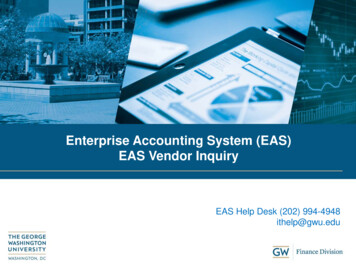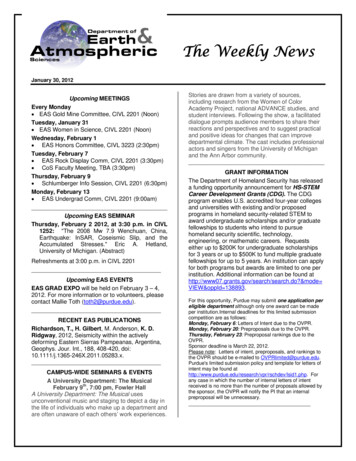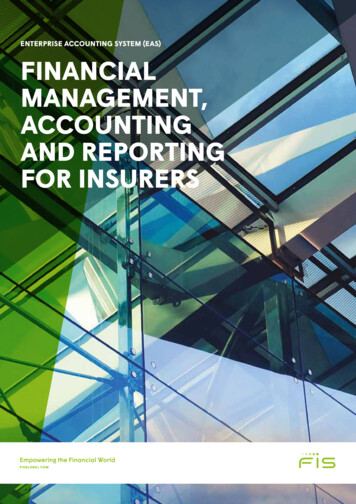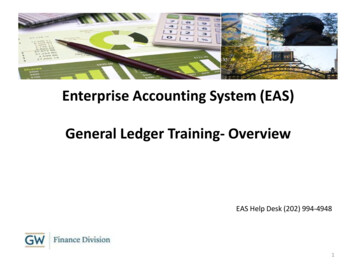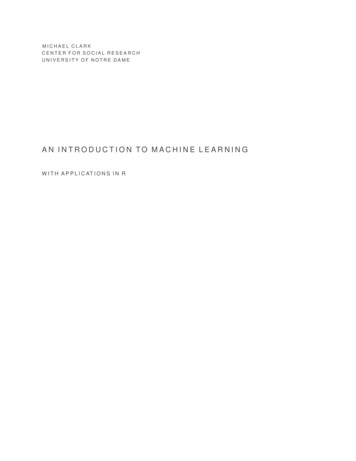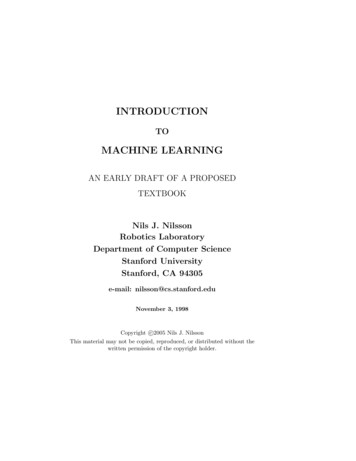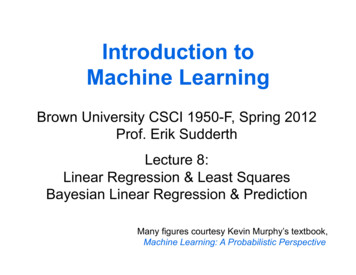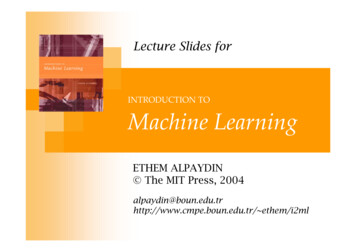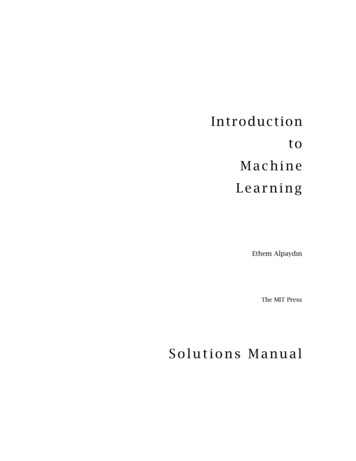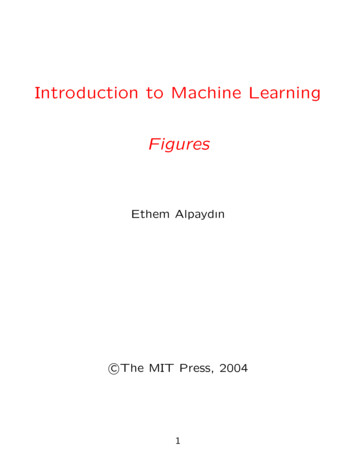
Transcription
Introduction to Machine LearningCS 586Machine LearningPrepared by Jugal KalitaWith help from Alpaydin’s Introduction to MachineLearning and Mitchell’s Machine Learning
Machine Learning: Definition Mitchell 1997: A computer program R is said tolearn from experience E with respect to some classof tasks T and performance measure P , if its performance at tasks in T as measured by P , improveswith experience. Alpaydin 2010: Machine learning is programmingcomputers to optimize a performance criterion using example data or past experience.1
Examples of Machine Learning Techniques andApplications Learning Association Learning how to classify Regression Unsupervised Learning Reinforcement Learning2
Learning Association This is also called (Market) Basket Analysis. If people who buy X typically also buy Y , and ifthere is a customer who buys X and does not buyY , he or she is a potential customer for Y . Learn Association Rules: Learn a conditional probability of the form P (Y X) where Y is the productwe would like to condition on X, which is a product or a set of products the customer has alreadypurchased.3
Algorithms for Learning Association The challenge is how to find good associations fastwhen we have millions or even billions of records. Researchers have come up with many algorithmssuch as– Apriori: The best-known algorithm using breadthfirst search strategy along with a strategy to generate candidates.– Eclat: Uses depth-first search and set intersection.– FP-growth: uses an extended prefix-tree to storethe database in a compressed form. Uses a divideand-conquer approach to decompose both themining tasks and the databases.4
Applications of Association Rule Mining Market-basket analysis helps in cross-selling products in a sales environment. Web usage mining. Intrusion detection. Bioinformatics.5
Algorithms for Classification Given a set of labeled data, learn how to classifyunseen data into two or more classes. Many different algorithms have been used for classification. Here are some examples:– Decision Trees– Artificial Neural Networks– K-nearest Neighbor Algorithm– Kernel Methods such as Support Vector Machines– Bayesian classifiers6
Example Training Dataset of Classification Taken from Alpaydin 2010, Introduction to MachineLearning, page 6. We need to find the boundary (here two lines) between the data representing classes.7
Applications of Classification Credit Scoring: Classify customers into high-riskand low-risk classes given amount of credit and customer information. Handwriting Recognition: Different handwriting styles,different writing instruments. 26 *2 52 classesfor simple Roman alphabet. determining car licenseplates for violation. Language models may be necessary. Printed Character Recognition: OCR, determiningcar license plates for driving violations. Issues arefonts, spots or smudges, figures for OCR, weatherconditions, occlusions, etc. Language models maybe necessary.8
Handwriting Recognition on a PDATaken /recognition.png.9
License plate RecognitionTaken from http://www.platerecognition.info/. This may be an image when acar enters a parking garage.10
Applications of Classification (Continued) Face Recognition: Given an image of an individual, classify it into one of the people known. Eachperson is a class. Issues iclude poses, lighting conditions, occlusions, occlusion with glasses, makeup,beards, etc. Medical Diagnosis: The inputs are relevant information about the patient and the classes are theillnesses. Features include patient’s personal information, medical history, results of tests, etc. Speech Recognition: The input consists of soundwaves and the classes are the words that can bespoken. Issues include accents, age, gender, etc.Language models may be necessary in addition tothe acoustic input.11
Face RecognitionTaken from http://www.uk.research.att.com.12
Applications of Classification (Continued) Natural Language Processing: Parts-of-speech tagging, parsing, machine translation, spam filtering,named entity recognition. Biometrics: Recognition or authentication of people using their physical and/or behavioral characteristics. Examples of characteristics: Images of face,iris and palm; signature, voice, gait, etc. Machinelearning has been used for each of the modalitiesas well as to integrate information from differentmodalities.13
POS taggingTaken gger-screenshot.jpg.14
Named Entity RecognitionTaken from http://www.dcs.shef.ac.uk/ hamish/IE/userguide/ne.jpg.15
Regression Regression analysis includes any techniques for modeling and analyzing several variables, when the focusis on the relationship between a dependent variableand one or more independent variables. Regressionanalysis helps us understand how the typical valueof the dependent variable changes when any one ofthe independent variables is varied, while the otherindependent variables are held fixed. Regression can be linear, quadratic, higher polynomial, log-based and exponential functions, etc.16
RegressionTaken from http://plot.micw.eu/uploads/Main/regression.png.17
Applications of Regression Navigation of a mobile robot, an autonomous car:The output is the angle by which the steering wheelshould be turned each time to advance without hitting obstacles and deviating from the root. Theinputs are obtained from sensors on the car: videocamera, GPS, etc. Training data is collected bymonitoring the actions of a human driver.18
Unsupervised Learning In supervised learning, we learn a mapping from input to output by analyzing examples for which correct values are given by a supervisor or a teacher ora human being. Examples of supervised learning: Classification, regression. In unsupervised learning, there is no supervisor. Wehave the input data only. The aim is to find regularities in the input.19
Unsupervised Learning: Clustering Bioinformatics: Clustering genes according to genearray expression data. Finance: Clustering stocks or mutual based on characteristics of company or companies involved. Document clustering: Cluster documents based onthe words that are contained in them. Customer segmentation: Cluster customers basedon demographic information, buying habits, creditinformation, etc. Companies advertise differentlyto different customer segments. Outliers may formniche markets.20
ClusteringTaken from a paper by Das, Bhattacharyya and Kalita, 2009.21
Applications of Clustering (continued) Image Compression using color clustering: Pixels inthe image are represented as RGB values. A clustering program groups pixels with similar colors inthe same group; such groups correspond to colorsoccurring frequently. Colors in a cluster are represented by a single average color. We can decidehow many clusters we want to obtain the level ofcompression we want. High level image compression: Find clusters in higherlevel objects such as textures, object shapes,wholeobject colors, etc.22
Reinforcement Learning In some applications, the output of the system is asequence of actions. A single action is not important alone. What is important is the policy or the sequence ofcorrect actions to reach the goal. In reinforcement learning, reward or punishment comesusually at the very end or infrequent intervals. The machine learning program should be able toassess the goodness of ”policies”; learn from pastgood action sequences to generate a ”policy”.23
Applications of Reinforcement Learning Game Playing: Games usually have simple rules andenvironments although the game space is usuallyvery large. A single move is not of paramount importance; a sequence of good moves is needed. Weneed to learn good game playing policy. Example: Playing world class backgammon or checkers.24
Applications of Reinforcement Learning(continued) Robot navigating in an environment: A robot islooking for a goal location to charge, or to pick uptrash, to pour a liquid, to hold a container or object.At any time, the robot can move in many in one ofa number of directions, or perform one of severalactions. After a number of trial runs, it should learnthe correct sequence of actions to reach the goalstate from an initial state, and do it efficiently. Orit should learn what sequence of actions causes itto pick up most amount of trash.25
Relevant Disciplines Artificial intelligence Computational complexity theory Control theory Information theory Philosophy Psychology and neurobiology Statistics Bayesian methods ···26
What is the Learning Problem?: A SpecificExample in Details Reiterating our definition: Learning Improvingwith experience at some task– Improve at task T– with respect to performance measure P– based on experience E. Example: Learn to play checkers– T : Play checkers– P : % of games won in world tournament– E: opportunity to play against self27
CheckersTaken from s.htm. 64 squares on board. 12 checkers for each player. Flip a coin to determine black or white. Use only black squares. Move forward one space diagonally and forward. Nolanding on an occupied square.28
Checkers: Standard rules Players alternate turns, making one move per turn. A checker reaching last row of board is ”crowned”.A king moves the same way as a regular checker,except he can move forward or backward. One must jump if its possible. Jumping over opponent’s checker removes it from board. Continuejumping if possible as part of the same turn. You can jump and capture a king the same way asyou jump and capture a regular checker. A player wins the game when all of opponent’scheckers are captured, or when opponent is completely blocked.29
Steps in Designing a Learning System Choosing the Training Experience Choosing the Target Function: What should belearned? Choosing a Representation for the Target Function Choosing a Learning Algorithm30
Type of Training Experience Direct or Indirect?– Direct: Individual board states and correct movefor each board state are given.– Indirect: Move sequences for a game and the final result (win, loss or draw) are given for a number of games. How to assign credit or blame toindividual moves is the credit assignment problem.31
Type of Training Experience (continued) Teacher or Not?– Supervised: Teacher provides examples of boardstates and correct move for each.– Unsupervised: Learner generates random gamesand plays against itself with no teacher involvement.– Semi-supervised: Learner generates game statesand asks the teacher for help in finding the correct move if the board state is difficult or confusing.32
Type of Training Experience (continued) Is the training experience good?– Do the training examples represent the distribution of examples over which the final systemperformance will be measured?– Performance is best when training examples andtest examples are from the same/a similar distribution.– Our checker player learns by playing against oneself. Its experience is indirect. It may not encounter moves that are common in human expert play.33
Choose the Target Function Assume that we have written a program that cangenerate all legal moves from a board position. We need to find a target function ChooseM ove thatwill help us choose the best move among alternatives. This is the learning task. ChooseM ove : Board M ove. Given a board position, find the best move. Such a function is difficultto learn from indirect experience. Alternatively, we want to learn V : Board ".Given a board position, learn a numeric score forit such that higher score means a better board position. Our goal is to learn V .34
A Possible (Ideal) Definition for Target Function if b is a final board state that is won, then V (b) 100 if b is a final board state that is lost, then V (b) 100 if b is a final board state that is drawn, then V (b) 0 if b is a not a final state in the game, then V (b) V (b ), where b is the best final board state that canbe achieved starting from b and playing optimallyuntil the end of the game.This gives correct values, but is not operational becauseit is not efficiently computable since it requires searching till the end of the game. We need an operationaldefinition of V .35
Choose Representation for Target FunctionWe need to choose a way to represent the ideal targetfunction in a program. A table specifying values for each possible boardstate? collection of rules? neural network ? polynomial function of board features? .We use V̂ to represent the actual function our programwill learn. We distinguish V̂ from the ideal target function V . V̂ is a function approximation for V .36
A Representation for Learned Function w0 w1 · x1(b) w2 · x2(b) w3 · x3(b) w4 · x4(b) w5 · x5(b) w6 · x6(b)V̂x1(b): number of black pieces on board bx2(b): number of red pieces on bx3(b): number of black kings on bx4(b): number of red kings on bx5(b): number of red pieces threatened by black(i.e., which can be taken on black’s next turn) x6(b): number of black pieces threatened by red It is a simple equation. Note a more complex representation requires more training experience to learn.37
Specification of the Machine Learning Problemat this time Task T : Play checkers Performance Measure P : % of games won in worldtournament Training Experience E: opportunity to play againstself Target Function: V : Board " Target Function Representation:V̂ w0 w1 · x1(b) w2 · x2(b) w3 · x3(b) w4 · x4(b) w5 · x5(b) w6 · x6(b)The last two items are design choices regarding how toimplement the learning program. The first three specifythe learning problem.38
Generating Training Data To train our learning program, we need a set oftraining data, each describing a specific boar
Machine Learning: Definition Mitchell 1997: A computer program R is said to learn from experience E with respect to some class of tasks T and performance measure P, if its per- formance at tasks in T as measured by P, improves with experience. Alpaydin 2010: Machine learning is programming computers to optimize a performance criterion us-
